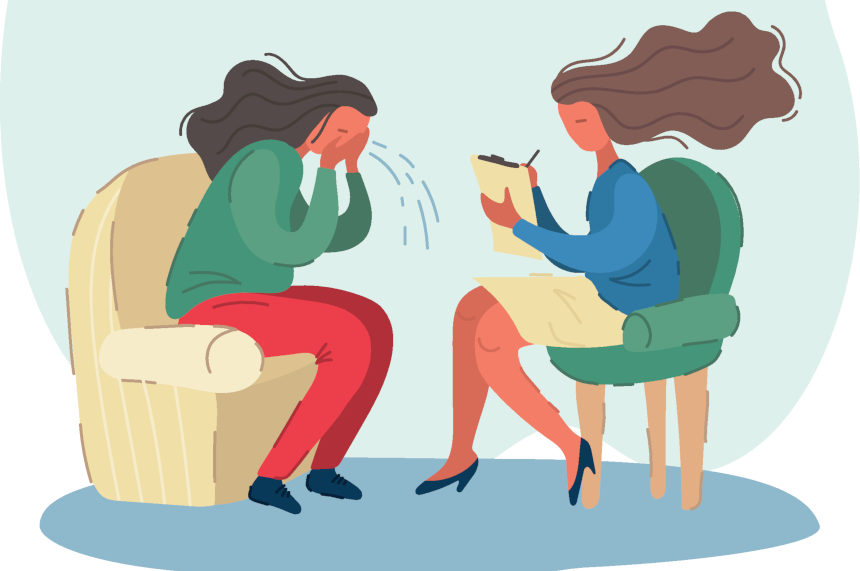In my final year of graduate school, I was required to do a clinical traineeship.
The traineeship is like a baby version of the 3,000-hour internship that comes later and is required for licensure. By this point, I’d taken the necessary coursework, participated in classroom role-play simulations, and watched countless hours of videotape of renowned therapists conducting sessions. I’d also sat behind a one-way mirror and observed our most skilled professors in real-time therapy sessions.
Now it was time to get in a room with my own patients. Like most trainees in the field, I’d be doing this under supervision at a community clinic, much the way medical interns get their training in teaching hospitals.
On my first day, immediately after the orientation, my supervisor hands me a stack of charts and explains that the one on top will be my first case. The chart contains only basic information — name, birth date, address, phone number. The patient, Michelle, who is 30 and has listed her boyfriend as her emergency contact, will be arriving in an hour.
If it seems strange that this clinic is letting me, a person who has performed exactly zero hours of therapy, take on somebody’s treatment, it’s simply the way therapists are trained — by doing. Medical school was also a trial by fire; in medicine, students learned procedures by the “see one, do one, teach one” method. In other words, you watched a physician, say, palpate an abdomen, you palpated the next abdomen yourself, and then you taught another student how to palpate an abdomen. Presto! You’re deemed competent to palpate abdomens.
Therapy, though, felt different to me. I found performing a concrete task with specific steps, like palpating an abdomen or starting an IV, less nerve-racking than figuring out how to apply the numerous abstract psychological theories I’d studied over the past several years to the hundreds of possible scenarios that any one therapy patient might present.
As if on cue, she starts crying. And by crying, I mean howling in the way one might if just informed that the person she loves in the world has just died.
Still, as I make my way to the waiting room to meet Michelle, I’m not terribly worried. This initial 50-minute session is an intake, which means I’ll gather a history and establish some rapport with her. All I have to do is collect information using a specific set of questions as my guide; then I’ll bring those results to my supervisor so that we can formulate a treatment plan. I spent years as a journalist asking probing questions and establishing a comfort level with people I didn’t know. How hard, I think, can this be?
Michelle is tall and too thin. Her clothes are rumpled, her hair unkempt, her skin pasty. Once we’re seated, I open by asking what brings her here, and she tells me that recently she has had trouble doing anything but cry.
Then, as if on cue, she starts crying. And by crying, I mean howling in the way one might if just informed that the person she loves most in the world has just died. There’s no warm-up, no wetness in her eyes that leads to a light drizzle and gradually a downpour. This is a level-four tsunami. Her entire body shakes, mucus drips from her nose, wheezy noises emanate from her throat, and, frankly, I’m not sure how she can breathe.
We’re 30 seconds in. This isn’t how the simulated intakes went at school.
Unless you’ve sat alone in a quiet room with a sobbing stranger, you don’t really know how simultaneously awkward and intimate it feels. To make matters weirder, I have no context for this outburst, because I haven’t gotten to the history part yet. I know nothing about this very distressed person sitting five feet away from me.
I’m not sure what to do or even where to look. If I look right at her, will she feel self-conscious? If I look away, will she feel ignored? Should I say something to engage with her or wait for her to finish crying? I’m so uncomfortable that I worry a nervous giggle might erupt. I try to stay focused, thinking about my list of questions, and I know I should be asking how long she’s felt this way (“history of present condition”), how severe it’s been, whether something happened that brought this on (a “precipitating event”).
But I do nothing. I wish that my supervisor were in the room with me right now. I feel totally useless.
The tsunami continues with no sign of letting up. I consider waiting it out, figuring she’ll run out of steam soon and then be ready to talk, the way my son would as a toddler after throwing a tantrum. But it just keeps going. And going. Finally I decide to say something, but as the words leave my lips, I’m convinced I’ve just uttered the dumbest thing that any therapist has ever said in the history of the field.
I say, “Yeah, you seem depressed, all right.”
I feel bad for this woman the instant I say it, like I should punctuate it with a big duh. This poor, depressed 30-year-old is in tremendous pain, and she isn’t coming here so that a trainee on her first day can state the blatantly obvious. As I try to think how to correct my error, I wonder if she’ll request a different therapist. I’m sure she isn’t going to want somebody like me in charge of her care.
But instead, Michelle stops crying. As quickly as she started, she wipes the tears away with a tissue and takes a long, deep breath. And then she half smiles. “Yeah,” she says. “I am so f-ing depressed.” She seems almost giddy to be saying this aloud. It’s the first time, she tells me, that somebody has said the word depressed about her condition.
She goes on to explain that she’s an architect who’s had some success, having been part of a team that designed a few high-profile buildings. She’s always been melancholy, she says, but nobody really knows the extent of it because she’s generally social and busy. About a year ago, though, she noticed a change. Her energy level decreased, as did her appetite. Just getting out of bed each morning felt like a huge effort. She wasn’t sleeping well. She fell out of love with her live-in boyfriend but wasn’t sure if it was because she was so down or because he wasn’t the right person for her. In the past few months, she’s been secretly crying every night in the bathroom while her boyfriend sleeps, making sure not to wake him. She’s never cried in front of anybody the way she has just cried in front of me.
She cries some more, and through her tears, she says, “This is like … emotional yoga.” What has brought her here now, she confides, is that her work has started getting sloppy and her boss noticed. She can’t concentrate because trying not to cry is taking all of her focus. She looked up the symptoms of depression and ticked off all the boxes. She’s never been in therapy before but knows she needs help. Nobody, she says, looking me in the eye — not her friends, not her boyfriend, not her family — knows how depressed she is. Nobody but me. Me. The trainee who has never done therapy before.
(If you ever want proof that what people present online is a prettier version of their lives, become a therapist and google your patients. Later, when I googled Michelle out of concern, I learned quickly never to do this again, to always let patients be the sole narrators of their stories — pages of hits popped up. I saw images of her receiving a prestigious award, smiling at an event standing next to a handsome guy, looking cool and confident and at peace with the world in a magazine photo spread. Online, she bore no resemblance to the person who sat across from me in that room.)
I can’t completely block out my thoughts: Do the other trainees know how to do this the first time out?
Now I talk to Michelle about her depression, find out if she’s contemplating suicide, get a sense of how functional she is, what her support system is like, what she does to cope. I’m mindful of the fact that I’ve got to bring a history to my supervisor — the clinic needs it for its records — but every time I ask a question, Michelle segues into something that leads us in a completely different direction. I subtly redirect, but that inevitably takes us someplace else, and I’m very aware that I’m getting nowhere with the history.
I decide to just listen for a while, but I can’t completely block out my thoughts: Do the other trainees know how to do this the first time out? Can you get fired from this gig on your first day? And, when Michelle starts crying again, Is there anything I can do or say that will help her even the slightest bit before she leaves in … wait, how many minutes are left?
I glance at the clock on the table next to the sofa. Ten minutes have passed.
No, I think. Surely we’ve been in here for more than 10 minutes! It seems more like 20 or 30 or … I have no idea. Has it been only 10? Now Michelle is going into great detail about all the ways she’s screwing up her life. I go back to listening, then glance at the clock again: it’s still 10 minutes past the hour.
That’s when I realize: The clock hands aren’t moving! The battery must have died. My cellphone is in another room, and while it’s likely that Michelle has one in her bag, I can’t exactly ask her what time it is in the middle of her story.
Great.
Now what? Should I arbitrarily say “Our time is up,” even though I have no sense of whether 20 or 40 or 60 minutes have passed? What if I cut it off way too early or too late? I’m supposed to see my second new patient after this. Is he sitting in the waiting room wondering if I’ve forgotten his appointment?
Panicking, I’m no longer paying close attention to what Michelle is saying. Then I hear this: “Is it over already? That went faster than I expected.”
“Hmm?” I say. Michelle points to somewhere behind my head and I turn around to look. There’s a clock on the wall right behind me so that patients can also see the time.
Oh. I had no idea, and I hope that she has no idea that I had no idea. All I know is that my heart is racing and that, though the session has gone quickly for Michelle, it felt like an eternity to me. It would take practice before I’d come to feel the rhythm of every session by instinct, to know that there was an arc to every hour, with the most intense parts in the middle third, and that you needed about 3 or 5 or 10 minutes to put the patient back together, depending on the person’s fragility, the subject matter, the context. It would take years to learn what should or shouldn’t be brought up when and how to work with the time available to get the most out of it.
I walk Michelle out, ashamed about getting flustered and distracted, of not gathering the history and having to report to my supervisor empty-handed. All through graduate school, we students had been awaiting the Big Day when we would lose our therapeutic virginity, and now, I think, mine turned out to be more disgrace than thrill.
Then, relief: Discussing the session that afternoon with my supervisor, she says that, despite my clumsiness, I did just fine. I’d sat with Michelle in her suffering, which for many people can be an unusual and powerful experience. Next time I won’t worry so much that I have to do something to stop it. I’d been there to listen when she needed to unload the burdensome secret of her depression. In the parlance of therapeutic theory, I’d “met the patient where she was” — history-taking be damned.
Years later, when I’ve done thousands of first sessions, and information-gathering has become second nature, I’ll use a different barometer to judge how it went: Did the patient feel understood? It always amazes me that someone can walk into a room as a stranger and then, after 50 minutes, leave feeling understood, but it happens nearly every time. When it doesn’t, the patient doesn’t return. And because Michelle did, something had gone right.
As for the clock snafu, though, my supervisor doesn’t mince words: “Don’t BS your patients.”
She lets that sink in, then goes on to explain that if I don’t know something, I should simply say, “I don’t know.” If I’m confused about the time, I should tell Michelle that I need to step out of the room for a second to bring in a working clock so that I’m not distracted. If I’m to learn anything in this traineeship, my supervisor emphasizes, it’s that I can’t help anybody unless I’m authentic in that room. I had cared about Michelle’s well-being, I’d wanted to help, I’d done my best to listen — all key ingredients for starting the relationship.
I thank her and start toward the door.
“But,” my supervisor adds, “be sure to get that history in the next couple of weeks.”
Over the next few sessions, I get what I need for the clinic’s intake form, but it’s clear to me that’s all it is — a form. It takes a while to hear a person’s story and for that person to tell it, and like most stories — including mine — it bounces all over the place before you know what the plot really is.
Tech Disconnect
When social media keeps us apart
We’re all getting more connected, but not in the way we would if we spoke to each other face to face, says psychotherapist Lori Gottlieb, who describes her training in her book Maybe You Should Talk to Someone. She says the minute a therapy session ends, or even at a break in the conversation, “The first thing they do is look at their phones.”
Device compulsion can be observed everywhere, she says. Groups of people are ostensibly spending time together but are actually alone in their devices. Gottlieb worries we may “lose our ability to be with others. We are very lonely. Community has changed drastically.”
Not that she’s immune: “I didn’t grow up with devices,” she says, “but I’m as dependent as the next person.”
It’s not just about mobile phones. Gottlieb feels our dependence underlines a larger cultural issue of instant gratification. We now live in a constantly plugged-in era, with entertainment, commerce, and community a tap away; in that way, Gottlieb likens the internet to a “no prescription pain-killer.”
But what about using Facebook, Instagram, and Twitter to stay in touch with friends and relatives? Not the same as a phone call. Social media, Gottlieb argues, is really a “false sense of connection.” Sharing with others using technology is “reporting on your experience.” By contrast, when you sit down with someone and talk, “you’re having an actual shared experience.”
If you truly are feeling lonely, maybe, as her book title suggests, you should talk to someone. “No, not everyone needs therapy,” she says, “but it’s often very helpful for most people.” Gottlieb likens therapy to holding up a mirror to let you see your own situation. “That doesn’t mean you become a Pollyanna,” but that you can begin to “find joy or contentment or peace” by acknowledging the good things that you have.
—Troy Brownfield is a staff writer at the Post.
This article is featured in the May/June 2019 issue of The Saturday Evening Post. Subscribe to the magazine for more art, inspiring stories, fiction, humor, and features from our archives.
Featured image: Shutterstock
Become a Saturday Evening Post member and enjoy unlimited access. Subscribe now




Comments
I am not sure of the cause of COPD in my case. I smoked pack a day for 12 or 13 years, but quit 40 years ago. I have been an outdoor person all my adult life. Coughing started last summer producing thick mucus, greenish tint to clear. I tried prednisone and antibiotics, but no change. X-rays are negative, heart lungs and blood and serum chemistries all are normal. I have lung calcification from childhood bout with histoplasmosis. I am 75 years old and retired.My current doctor directed me to totalcureherbsfoundation.com which I purchase the COPD herbal remedies from them ,they are located in Johannesburg, the herbal treatment has effectively reduce all my symptoms totally, am waiting to complete the 15 weeks usage because they guaranteed me total cure.